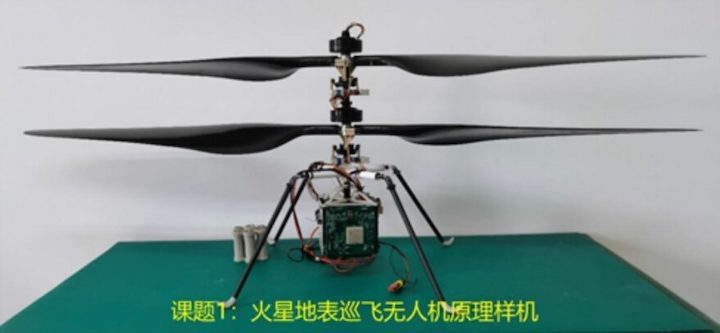2.09.2021

The Mars surface cruise drone prototype developed by China’s NSSC. Credit: NSSC/CAS
HELSINKI — China is looking at ways of expanding its space exploration capabilities including through a vehicle similar in appearance to NASA’s Ingenuity helicopter.
A prototype of “Mars surface cruise drone” passed a final acceptance review Aug. 20, the National Space Science Center (NSSC) under the Chinese Academy of Sciences (CAS) announced Wednesday.
The rotorcraft was one of three projects in a technology cultivation program promoted by the NSSC. The vehicle project was led by Bian Chunjiang of the NSSC and features a micro spectrometer.
The concept could be considered for future Chinese Mars exploration but the NSSC did not identify a mission on which the drone may fly.
China’s first Mars mission, Tianwen-1, entered orbit around the Red Planet in February. This feat was followed by a successful landing of the roughly 240-kilogram, solar-powered Zhurong rover in May. China’s next Mars mission is currently listed as a sample return mission, launching in the 2028 or 2030 launch windows.
The China Academy of Launch Vehicle Technology (CALT) in June outlined a study of propulsion needed for future, long term crewed expeditions to Mars, including precursor robotic missions. The study identified favorable launch windows but did not provide a timeline for either the crewed or uncrewed missions.
The concept of flying a craft on Mars has recently been verified by NASA. The Perseverance rover landed on Mars in February, carrying with it the 1.8-kilogram Ingenuity helicopter. The vehicle made the first powered flight by an aircraft on another world in April and conducted its 12th and most recent flight Aug. 16, covering a horizontal distance of 450 meters across 169.5 seconds of flight.
NASA is now examining concepts for larger, more capable rotorcraft for future missions. The agency will in 2027 launch the Dragonfly drone to Titan, the largest moon of Saturn, arriving in 2034. Dragonfly was selected as a New Frontiers planetary science mission.
China’s own pursuit of flying an aircraft in the thin Martian atmosphere is not new. A concept from the Qian Xuesen Laboratory of Space Technology was considered for the country’s 2020 Mars mission. As well as a rover, the ambitious proposal included three ground penetrators, to be released during descent, and an aerostat which would operate at an altitude of between 1 and 5 kilometers for one week. The objective would have been to obtain “three-dimensional, multi-layer and multi-source information” with one landing.
Entities including the Beijing Institute of Spacecraft System Engineering and Shenzhen Aerospace DFH HIT Satellite Ltd., both under the China Academy of Space Technology (CAST), and Beihang University have been embarked on work on concept architectures for Mars exploration.
The first is a winged drone, a design chosen over a helicopter due to the challenges of high rotation speed and requirements for an ultralight structure and high efficiency power system posed by the latter. The drone would lift off vertically from the surface of Mars before pitching and deploying its wings. The vehicle would have a range of tens of kilometers, collecting and potentially analyzing atmosphere and surface samples. It would also be capable of entering otherwise prohibitive environments such as canyons and craters.
The group also put forward a balloon concept, carrying a tethered 2U CubeSat. The system would seek to take atmospheric samples at various altitudes for analysis, while also returning high-resolution imagery and other data.
China’s Tianwen-1 mission carried surprises in the form of an ejected deep space camera and a rover-deployed camera to allow a joint rover-landing platform photo. With innovative and newly-proven concepts already being developed, competition for a place aboard future Chinese exploration missions is likely to be strong.
Quelle: SN
